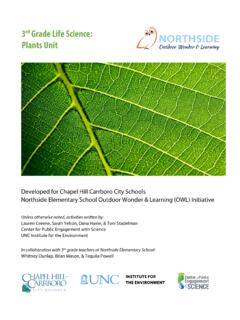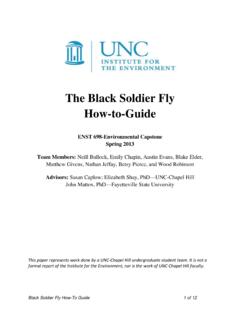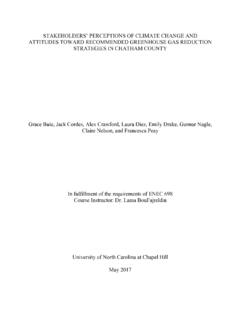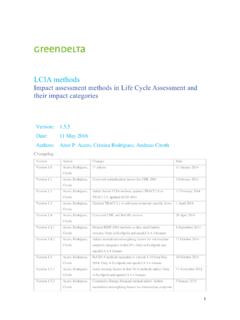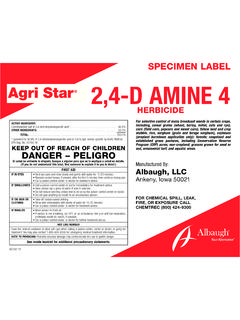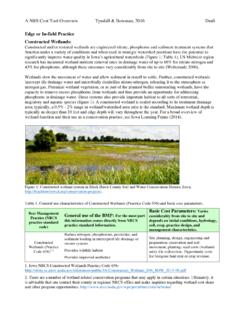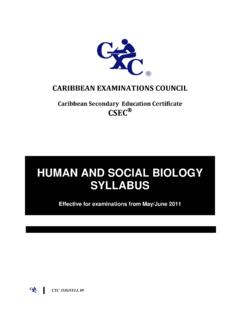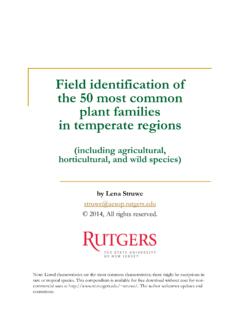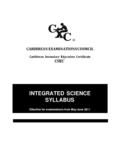Transcription of 5th Grade Life Science: Ecosystems Unit
1 Developed for Chapel Hill Carrboro City Schools Northside Elementary School Outdoor Wonder & Learning (OWL) Initiative Unless otherwise noted, activities written by: Lauren Greene, Sarah Yelton, Dana Haine, & Toni Stadelman Center for Public Engagement with Science UNC Institute for the Environment In collaboration with 5th Grade teachers at Northside Elementary School: Michelle Gay, Daila Patrick, & Elizabeth Symons 5th Grade Life Science: Ecosystems Unit ACKNOWLEDGEMENTS Many thanks to Dan Schnitzer, Coretta Sharpless, Kirtisha Jones and the many wonderful teachers and support staff at Northside Elementary for their participation in and support of the Northside OWL Initiative.
2 Thanks also to Shelby Brown for her invaluable assistance compiling, editing, and proofreading the curriculum. Instructional materials and supplies to promote STEM-based outdoor learning were instrumental to the successful implementation of this curriculum. The purchase of these materials was made possible with funding provided by the Duke Energy Foundation to Chapel Hill-Carrboro City Schools. Curriculum developed June 2018 July 2019 For more information, contact: Sarah Yelton, Environmental Education & Citizen Science Program Manager UNC Institute for the Environment Center for Public Engagement with Science 5th Grade Ecosystems UnitNorthside Outdoor Wonder & Learning InitiativeOverarching Unit Question How and why do organisms (including humans) interact with their environment, and what are the effects of these interactions?
3 Essential Questions Arc 1: How can I describe and compare different Ecosystems ? Arc 2: How is energy transferred through an ecosystem? How can I explain the interconnected relationships between organisms and their environments? Transfer Goals oUse scientific thinking to understand the relationships and complexities of the world around real-world dilemmas and opportunities and apply scientific thinking to develop solutions for Understandings (Science) The world has many different environments, and distinct environments support the life of different types oforganisms.
4 Organisms within Ecosystems are interdependent and can survive only in environments in which theirneeds can be met. A ll organisms cause changes in the environment where they live and they, in turn, are affected by changesin their Science Essential Standards Understand the interdependence of plants and animals with their Compare the characteristics of several common Ecosystems , including estuaries and salt marshes, oceans,lakes and ponds, forests, and grasslands. Classify the organisms within an ecosystem according to the function they serve: producers, consumers,or decomposers (biotic factors).
5 Infer the effects that may result from the interconnected relationship of plants and animals to theirecosystem. Secondary Target Standards (ELA, Math, Social Studies) ELA Quote accurately from a text when explaining what the text says explicitly and when drawing inferences from the text. Determine two or more main ideas of a text and explain how they are supported by key details; summarize the text. Determine the meaning of general academic and domain-specific words and phrases in a text relevant to a Grade 5 topic or subject area. Engage effectively in a range of collaborative discussions (one-on-one, in groups, and teacher-led) with diverse partners on Grade 5 topics and texts, building on others ideas and expressing their own clearly.
6 5th Grade Ecosystems Unit1 Northside Outdoor Wonder & Learning Report on a topic or text or present an opinion, sequencing ideas logically and using appropriate facts and relevant, descriptive details to support main ideas or themes; adapt speech to a variety of contexts and tasks. Determine and/or clarify the meaning of unknown and multiple-meaning words and phrases based ongrade 5 reading and content, choosing flexibly from a range of strategies: context clues, word parts, word relationships, and reference materials. Acquire and use accurately Grade -appropriate general academic and domain-specific words and phrases,including those that signal contrast, addition, and other logical relationships.
7 Math Represent and interpret Studies Explain the impact of the physical environment on early settlements in the New Explain the positive and negative effects of human activity on the physical environment of the UnitedStates, past and present. Unit Overview In this unit students will learn how all living organisms are interdependent upon each other, as well as the non-living factors within an ecosystem. The activities in this unit provide students with opportunities to develop skills such as observation, critical thinking, communication, collaboration, and creativity.
8 They will investigate their school yard and Ecosystems surrounding it by using direct observations and completing nature journaling activities. In Arc 1, students learn about the abiotic and biotic factors in Ecosystems . They begin exploring the ecosystem around their schoolyard and record their observations in a nature journal. Students then take a virtual trip down the Cape Fear River and discover different types of aquatic and terrestrial Ecosystems . They explore ocean habitats and the creatures that inhabit different ocean zones and play a game to match animals to their Ecosystems .
9 The Arc wraps up by having students revisit their schoolyard to compare and contrast how it looks now and how it may have looked 250 years ago. Arc 2 provides students with opportunities to learn how energy flows through Ecosystems by studying food chains and food webs. The Arc begins with students learning about ecology, which is the study of the relationships between plants, animals, people, and their environment. Other activities allow students to analyze what happens when food chains and food webs become unbalanced through changes in the environment. As students work through these activities, they gain an understanding of how organisms are interdependent within an ecosystem.
10 The unit wraps up with an exploration of how Ecosystems provide services that impact human health. Duration 20-24 days of 45 minute learning activitiesVocabulary *Ecosystem, environment, biome, terrestrial , tundra, taiga, deciduous forest, rainforest, grassland, desert, aquatic , wetland, ocean, river, lake, pond, estuary, organism, biotic, abiotic, producer, consumer, decomposer, predator, prey, herbivore, carnivore, omnivore, scavenger, food chain, food web, population, community, competition, photosynthesis, organic, biodiversity, interdependence, conservation.



